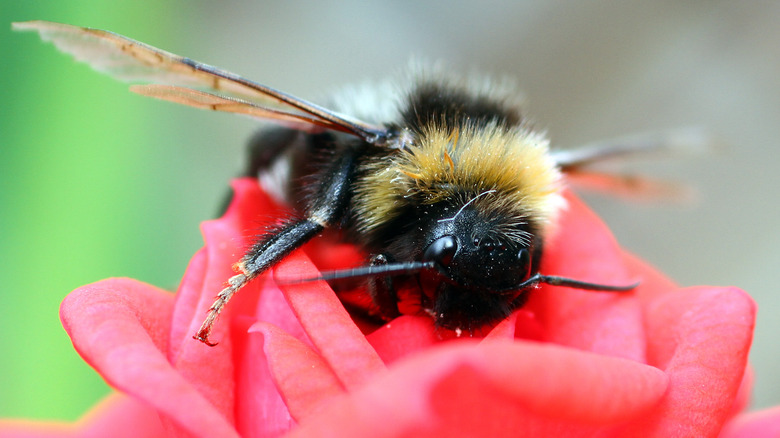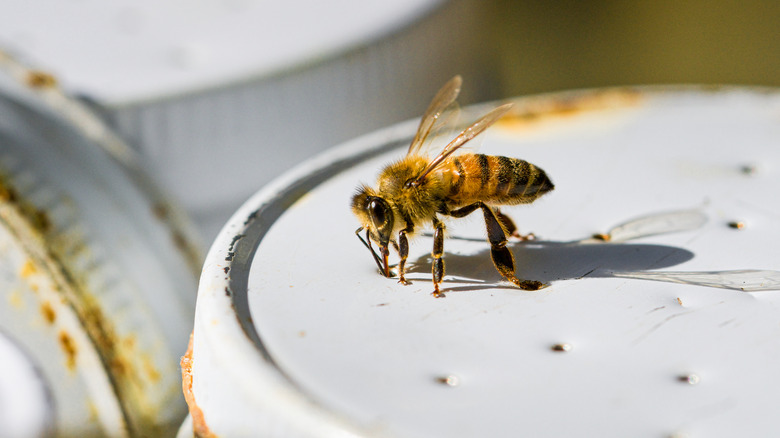Save Your Mason Jars To DIY A Waterer For Exhausted Pollinators This Summer
We may receive a commission on purchases made from links.
Our pollinators need abundantly resourced habitats. To bring more pollinators into your yard and garden, you need lots of nectar and pollen-producing flowers, places for bugs to nest and hide from predators, and a reliable source of clean water. The same goes for more human-assisted pollinator populations like backyard beehives. A long, hot summer is tough on everyone, our hard-working pollinating insect friends included. Like humans, having a clean, fresh water source when temperatures get high can mean the difference between barely surviving — or worse, expiring — and thriving.
Even beginner beekeepers and gardeners are probably already familiar with using jars to quench the thirst of bees or other pollinators. You can, after all, buy kits containing a jar with holes punched in the lid and a tiered plastic base. In the base is a small pool of constantly refilling water and a ledge for thirsty critters to sit on while they drink. Some experts claim, however, that these ready-made jar feeders are dangerous for bugs. With their thin, tapered base, they're designed to tuck in under the entrance to a beehive or sit atop a patio railing. This blocks the entrance, making it difficult for the bees to defend their water source from poachers. Having the water sitting in the tray, open to the air, risks exposing the water to and potentially contaminating it with insecticides. Plus, why buy something from the store when you could make it yourself with unused Mason jars?
Find or buy your jars
If pre-loved jars aren't part of your kitchen cabinet clutter, you'll need to source or buy them elsewhere. Keep it within budget by perusing your local thrift stores or asking for jars in your community's Buy Nothing Facebook group — there's a group finder on the organization's website. If you prefer new jars, Amazon has a set of four 32-ounce wide-mouth Ball jars for $18.49. You can get a four-pack of pink (yes, pink!) vintage-esque Rubbermaid & Jarden 32-ounce Mason jars for $29.99 at Walmart.
Depending on your preferred method, you may also need two short, thin wooden slats, an old 100% cotton T-shirt, fabric scissors, a rubber band or thin zip tie longer than the circumference of your jar, and a porcelain plate with a foot ring that the mouth of your jar fits snugly within. Tools-wise, have handy an awl, hammer and nail, or drill with a 3/64-inch metal-piercing drill bit, a hand-held grinder, and goggles. Punch or drill eight or so holes in the lid. Fill the jar with water and screw the lid back on. Place the two wooden slats on the ground at a little less than a jar lid-width apart. Upturn the jar so the lid faces down and balance it atop the slats. This leaves a gap the bees and other critters can crawl through to reach the holes in the lid — and the life-giving liquid that drips out.
Formulate a bee-friendly fountain
Another option is to replace the lid with a square of cloth cut from the old cotton t-shirt. Secure it in place with a rubber band or zip tie pulled tight. As with the holes, the bees suck the water from the cloth. Having just one jar isn't very efficient; you'll have to refill it constantly. It's relatively easy to mount these feeders to a bespoke stand, creating an in-garden watering station (or stations). You can also fill these feeders with sugar syrup (be sure to follow an insect-safe recipe), but they need to be cleaned and sterilized often. No matter what you fill the jar with, keep them in the shade.
If you're a dab hand with a grinder, cut some grooves into the lip of the Mason jar — again, six to eight should do the trick. Find a clean, crack-and-chip-free ceramic plate with a foot ring the same width as the mouth of the jar. Place it right up on the top of the jar, the mouth sitting snugly inside the foot ring. Holding the plate firmly in place, quickly flip the jar upside down and put it on a completely flat surface. While this idea requires more DIY skills, it's decidedly more insect-friendly. The gentle slope of the plate provides a landing pad for critters to rest on as they drink — like the aforementioned commercial versions also have. However, this design doesn't have a pool of water for your winged friends to drown in.

